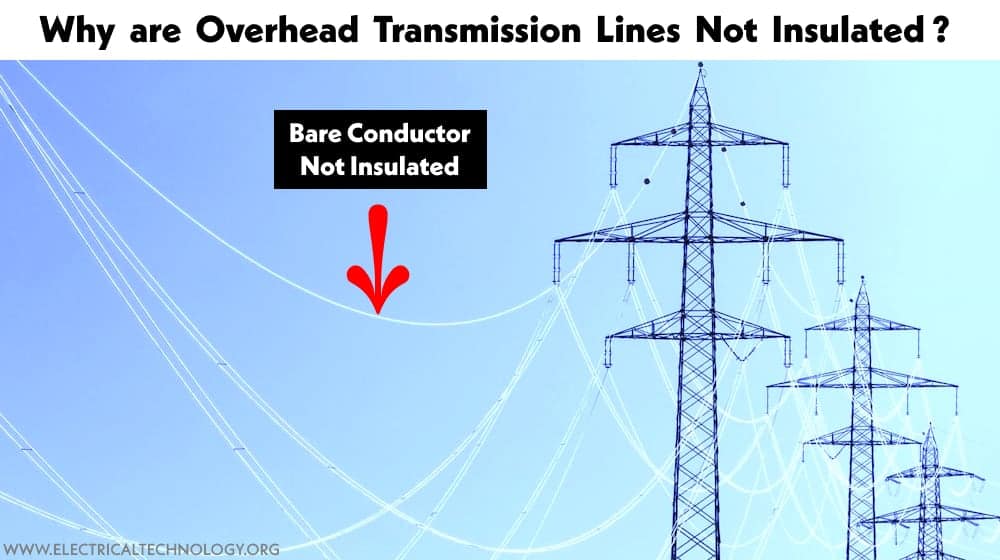Why are Overhead Power Transmission Lines Not Insulated?
Why Use Bare Conductors for Overhead Transmission Lines Instead of Insulated Conductors?
You may have noticed that we use insulated cables for underground power transmission, as well as in industrial and residential applications. Even in home applications, all the wires and cables are well insulated except for the bare conductor used for grounding purposes. Now, why don’t we use the same insulated cables for overhead transmission lines?
Why are High Voltage Wires Not Insulated?
Overhead transmission lines are not typically insulated for several reasons:
- Reduce Cost: Insulating overhead transmission lines over long distances would be extremely expensive. These lines can span hundreds of miles, and insulating them with traditional insulation materials would be financially impractical. Thus, power transmission and distribution companies save a huge amount of money by not insulating the overhead transmission lines.
- Reduce Weight: As the insulation depends on the voltage level, i.e., the higher the voltage, the thicker the insulation required. Hence, it puts a much heavier load when insulation is used for Extra High Voltage (EHV) transmission lines.
- Extra Materials: As we need thick insulation for EHV, it will increase the weight, which in turn requires stronger supports, insulators, and foundations for poles and towers. This means it will raise the overall cost and create a more complex system for achieving the same result that we can attain with bare wires for power transmission.
- Improve Conductivity: The dielectric strength of an insulator decreases as voltage increases. Now, imagine the thickness of the insulation required for extra high voltage, such as 450 kV to 600 kV. The thicker insulation used in transmission lines will hinder the efficient dissipation of heat in the power lines. That’s why using a bare conductor for power transmission lines improves overall conductivity.
- Maintenance: Maintaining insulated lines would be more challenging and costly. Regular inspections and maintenance (even with naked eyes and apparent look) would be required to ensure that the insulation is intact and functioning correctly.
- Heat Dissipation: Overhead transmission lines can generate significant heat due to the currents they carry. Insulation could trap this heat and potentially lead to overheating issues, which would be detrimental to the system’s reliability.
- Safety: While the conductors themselves are not insulated, overhead transmission lines are designed to be installed at a height that is difficult for people, vehicles, or wildlife to reach. Similarly, there is a sufficient gap between the power lines and the ambient surroundings, providing enough insulation between them to avoid additional faults in power system. This helps minimize the risk of accidental contact with the live conductors and protects the overhead power lines.
Instead of insulating the conductors, overhead transmission lines are designed with spacing between phase wires and ground clearances that prevent flashovers and electrical discharges. Additionally, insulating materials are used at specific points, such as insulators and bushings, where the lines connect to supporting structures and equipment to prevent electrical leakage and maintain safe operation. These design considerations help ensure the safe and reliable transmission of electrical power over long distances.
Related Posts:
- Why are “High Voltage” Signs used when Only Current Kills?
- Why Don’t Birds and Squirrels Get Electrocuted on Power Lines?
- What Happens When an AC Line Touches a DC Line?
- Why is the Grounding Wire Bare and Not Insulated?
- What is the Purpose of Ground Wire in Overhead Transmission Lines?
- Why is the Ground Wire Always Positioned Above the Overhead Power Lines?
- Difference Between Grounding, Earthing and Bonding
- Difference Between Real Ground and Virtual Ground
- What is the Difference Between Neutral, Ground and Earth?
- Why are Salt and Charcoal Added in Earthing Pit for Grounding?
- Why are Stones Used in an Electrical Substation?







